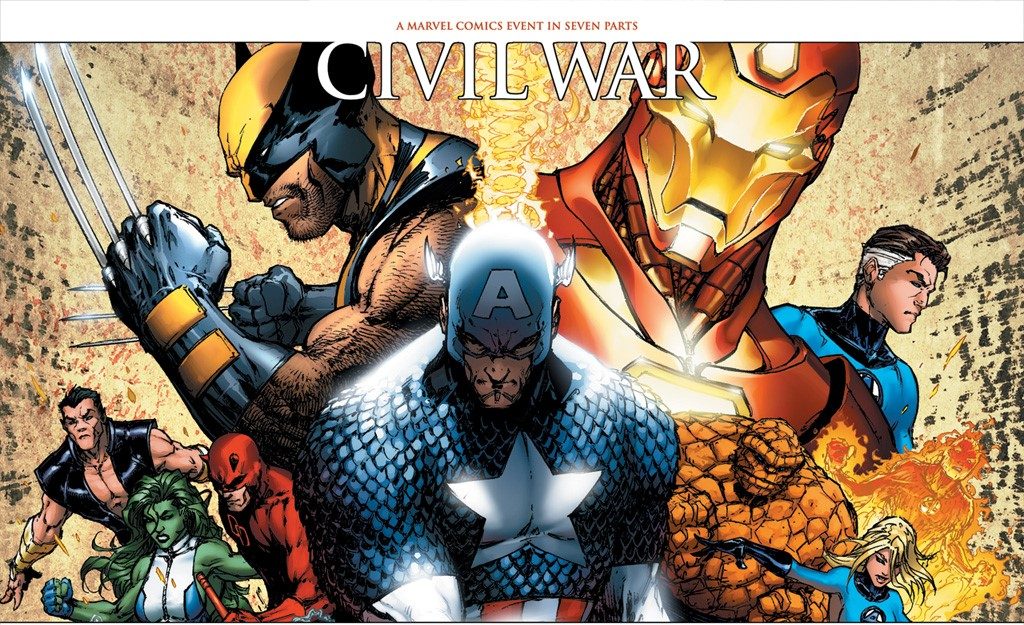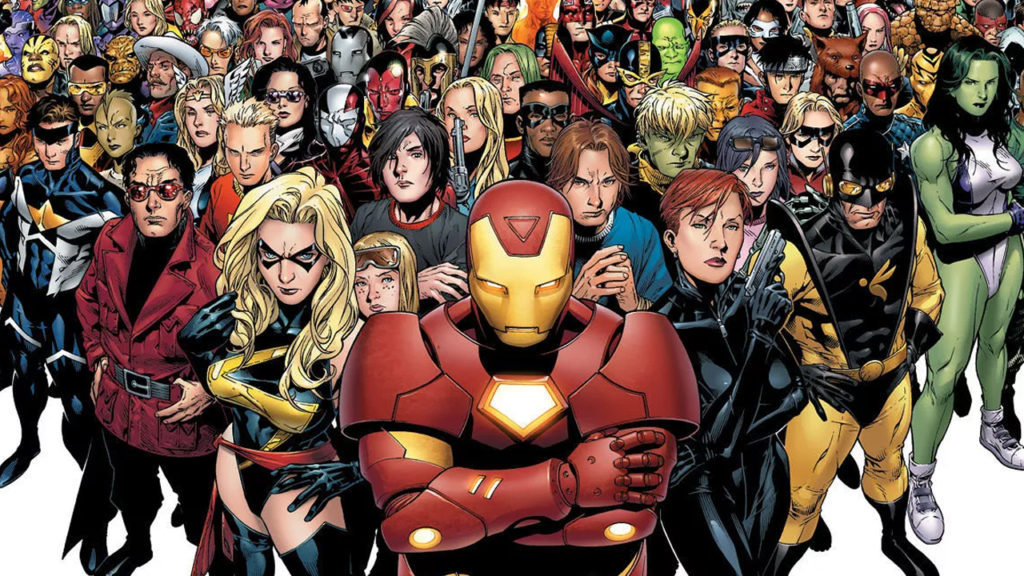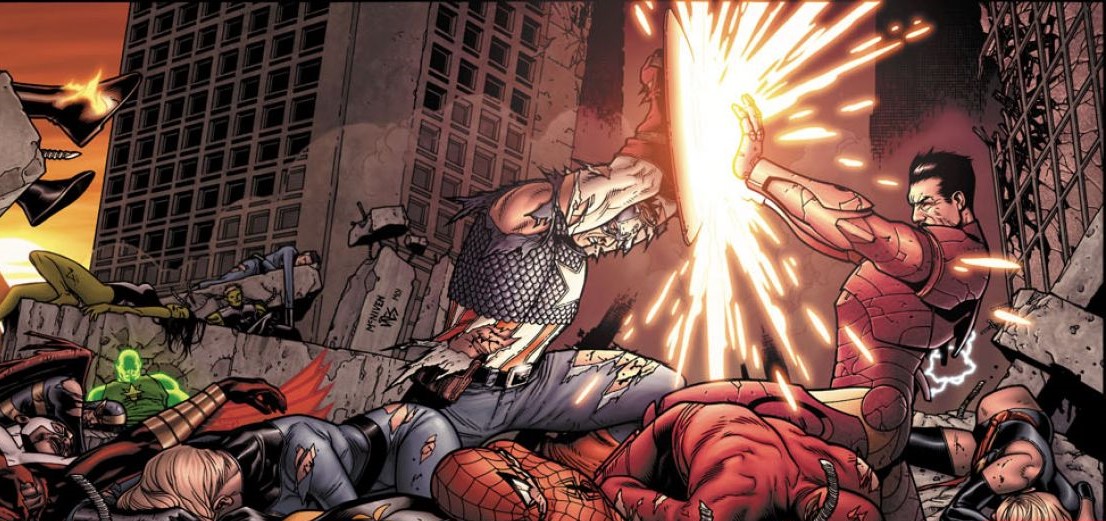Originally posted by Stuart Kirkman
Civil War is all around us. The first de facto issue of Marvel Comics summer event Civil War II is less than two weeks away, while Marvel Studio’s latest blockbuster Captain America:Civil War is still doing the rounds at theatres. When you consider Batman vs Superman and DC’s latest animated feature Justice League vs Teen Titans, the only logical thing to do is go and punch your best friend so you can be part of the club.
In order to take advantage of all this excitement, lets take a look back on something that happened nearly 10 years ago, and is still widely considered to be Marvel’s biggest comic book storyline. There’s no question that this book was a big deal at the time; but should it still be held in such high regard? To answer that question, we’ll look at the various aspects of Mark Millar and Steve McNiven’s Civil War story, including the event itself, the tie-in storylines, and the impact it had on the shared Marvel universe. But first…
The Build-Up
The catalyst that started the Superhero Civil War was the introduction of the Superhuman Registration Act; a law that required all meta-human’s to do three things:
- Register their identities with the government
- Receive training from the government
- Become an employee of the government
It made perfect sense at the time; there had been several superhero snafu’s that caused the deaths of a large number of innocent civilians, and this was a reaction to the public perception that spandex-clad morons were running around getting people killed. In Civil War issue 1, several recent storylines are name dropped as being responsible for this movement, including the Philadelphia bombing that occurred during Ed Brubaker’s Captain America, Wolverine’s attempt to kill the president in Mark Millar’s Enemy of the State, and the Hulk’s rampage through Las Vegas in Fantastic Four by J. Michael Straczynski.
The Las Vegas incident also precipitated a meeting of the clandestine superhero organisation the Illuminati, who first appeared in the second volume of Bendis’ New Avengers when they decided to do something about the Sentry situation. In the New Avengers: Illuminati special we’re given a glimpse at the origin of this team, which dates back to the early days of the Marvel Universe. Then in the present day they make the decision neutralise the Hulk problem by tricking him into repairing a satellite then blasting him into space. This issue was a timely reintroduction to the Illuminati, who would play a key role during Civil War, but it also teased the Superhuman Registration Act and set-up Greg Pak’s Planet Hulk story.
A few issues of Staczynski’s Spider-Man run are also important to the prelude as they help justify the unexpected position Peter Parker takes during the event. In these issues he forms a close relationship with Tony Stark, who gives him the Iron Spider costume and takes him under his wing, warning him about what was coming and influencing (or manipulating) him into joining the pro-registration side.
The Storyline
This feature is a bit spoilerific by it’s nature, but below is the only part that covers specific plot points. If you’d rather read the story itself than have it spoiled, you might want to skip to the next section.
STORY SPOILERS BELOW

Another superhero related disaster occurs in the opening pages of the first issue, when the town of Stamford, Connecticut is obliterated by Nitro a villain called Nitro, after an admittedly moronic super-team called the New Warriors botch an attempt to detain him while trying to make a TV show. This becomes the straw that broke the camels back, and the Registration Act is quickly passed into law, forcing every superhero to choose a side.
As you’d expect (if only because it makes for a better story) the superhero community divides down the middle; those that believe in security fight for governmental control, and those who believe in freedom above all else fight for their independence. Friends become enemies and enemies become friends, as both sides make some strange bedfellows in order to tip the balance in their favour. The leaders of each movement, Captain America and Iron Man, will have to decide just how far they’re willing to go to fight for what they believe in,
The entire conflict is personified in three characters:
- Captain America represents Anti-Registration, as his devout belief in freedom simply can’t co-exist with the Registration Act’s principles
- Iron Man represents Pro-Registration, as his futurist mentality understands the need to change with the times and win back the public’s confidence
- Spider-Man represents the reader in many ways, he is the moral centre of the Marvel Universe and as arguments are made for each side he must decide which he belongs on
As with a real Freedom vs Security debate, convincing arguments are made for both sides, but every story of this nature has to have a good guy and a bad guy. Both Steve and Tony compromise their beliefs to some extent in the pursuit of victory, as Cap allies with the Punisher, Tony creates a clone of Thor, and both sides recruit villainous allies. But rather than keeping the moral balance fairly equal, Millar shines a more virtuous light on Captain America, while slowly corrupting Iron Man.
During the final battle when triumph is within his grasp, Cap has a moment of clarity and realises that winning simply isn’t worth the price he’d have to pay. He surrenders himself to Iron Man, losing the war, but retaining the moral victory.
END OF STORY SPOILERS
The story has some strong beats; there are lots of big moments spread throughout the series, and a handful of them were even headline worthy. Mark Millar’s characters sometimes sounds the same and have a habit of coming across like total assholes, and even though he handles the pacing and balance quite well at the beginning, it kind of falls apart in the latter half. Steve McNiven’s artwork is worth the price of admission alone, as he delivers some of the best pencils of his career.
The Tie-Ins
As you’d expect, there’s a large number of connected stories in this event as Marvel capitalised on the mainstream attention it was receiving. Fortunately (and rather unusually) some of these tie-ins are actually good, and well worth buying to enhance the experience of the main story.
Ed Brubaker skilfully wove the events of Civil War into his own Captain America narrative, which doesn’t slow down for a second and comes off like it was planned from the start. Winter Soldier even gets a fantastic one-shot of his own called Winter Kills, which is set at Christmas and involves him teaming up with the Young Avengers for a raid on a Hydra base.
Speaking of Young Avengers, they have an enjoyable team-up with Brian K Vaughan’s Runaways, which will be the first of many meetings between these two groups. Both series are fantastic in their own right, and anyone that’s enjoyed either of them can’t go wrong checking out this mini-series.
Paul Jenkins teamed with various artists to tell a street-level story of the Civil Wars impact on regular people. Civil War: Frontline followed Ben Urich as he reported on the pro-registration side, and Sally Floyd as she investigated the dissidents. It covered the main plot points and focused on the more character driven human angle, while the main series delivered the blockbuster moments.
The Amazing Spider-Man issues are worth reading as Peter Parker probably has the most interesting story-arc of the whole cast, flip-flopping between sides and having his life turned upside down in typical Parker fashion. He personifies the argument really well and is caught between the two sides like no other character in the series.
A bucket-load of series tied into Civil War for one or more issues, and several one-shots were released as well, some of which are definitely worth reading. New Avengers tie-in issues were a series of one-shots focusing on the views of specific characters, the Fantastic Four were fractured by the war, with Reed joining Tony Stark and Sue & Johnny joining Captain America.
The Aftermath

The main thing to come out of Civil War didn’t actually occur during the event, but just afterwards in Captain America #25, where Steve Rogers was gunned down on the courthouse steps. This began an 18 issue Death of Captain America storyline, which is arguably Ed Brubaker’s finest work on the series. Jeph Loeb wrote a Fallen Son mini-series which was based around the five stages of grief, each issue featured a different character and artist as they dealt with one of the stages. This was a particularly personal project for Loeb as it was released soon after his son’s death. Brian Bendis and Alex Maleev also re-teamed for an emotional one-shot called Civil War: The Confession, which is one of the finest single issues in modern comics.
The immediate fallout of Civil War was the Registration Act itself; Iron Man was became Director of S.H.I.E.L.D. and started a new team in Mighty Avengers, while Luke Cage took over leadership of the New Avengers. Bendis wrote both books and the teams had several run-ins with other for a couple of years. The Registration Act had implications for most books, but it was moved to the background and didn’t affect that many stories in a serious way.
Iron Man eventually got a great new solo series called Invincible Iron Man, but it didn’t start until a few months after Civil War. Before then, Tony Stark spent the better part of six months getting his ass handed to him by every hero who cared to try, including Bucky Barnes, Spider-Man and Thor, who was less than pleased when he returned to the mortal world to find out that the clone Tony had made of him had gone on to murder one of his friends.
JMS started a storyline in Amazing Spider-Man called Back in Black which spilled into the Spider-Man family of books and involved Aunt May taking a bullet intended for Peter, who then went hunting for the persons responsible while she lay dying in hospital. It was a pretty dark chapter in Spider-Man’s life and it ultimately lead to the infamous Mary Jane marriage retcon in One More Day, which returned Peter Parker to the life of a bachelor, upsetting a lot of fans but reinvigorating the series and attracting a lot of new readers.
The villains Tony Stark recruited to fight in the Civil War formed a new Thunderbolts team, lead by Norman Osborn. This series was written by Warren Ellis with art by Mike Deodato, which was a lot of fun and would have some implications down the road. All in all, there was some pretty interesting stuff to come out of the series, even if the Registration Act was the least of it, and was largely ignored after a few months.
The Verdict
The Civil War series had three major selling points:
- Heroes fighting heroes, Captain America vs Iron Man
- Spider-Man unmasking in front of the world
- The death of Captain America
All three drove new and lapsed readers into comic shops for the first time in ages, generating a lot of money and interest in the medium. It wasn’t perfect by any stretch of the imagination, but it does stand as one of the better executed summer events with some of the most interesting tie-in stories and fallout. The book can still be read and enjoyed today, even though it might make you cringe in places, it reads like a blockbuster movie and looks great from start to finish. There are several ancillary titles worth owning depending on personal interest, but The Confession one-shot is essential for anyone reading the series.
Overall, if you’re wondering what all the fuss is about then you should definitely check it out. There are several ways to enjoy the story, including a new Oversized Hardcover, and a Civil War Box Set
that were just released. But if you want to sample everything that this event has to offer, then the best way to do it would be to subscribe to Marvel Comics Unlimited so you can read as much of it as you want.
This was a deeper-dive into the world of comics than we normally post on Out of Lives, so if this is something that you want more of, or you have any feedback you want to share please feel free to comment below. In the next week or so there’ll be a write-up of the spiritual sequel to this event: Civil War II, which is already ramping up, so check back in a few days time.








